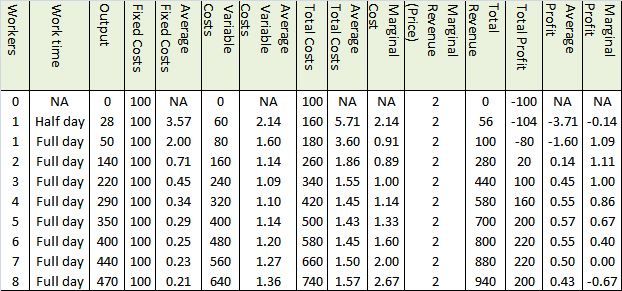The
definitions and the characteristics for the various terms need to be referred
to a standard text book.
This blog will discuss only the reason for why the profit
is maximized when Marginal cost curve crosses the Marginal revenue curve.
Abbrevations
MC= Marginal Cost
MR= Marginal Revenue
ATC= Average
Total Costs TC= Total Costs
AVC= Average
Variable Costs TR= Total Revenue
AFC= Average
Fixed Costs P= Price; Q= Quantity
Consider
the following example
The table
below gives the details of a factory producing a certain unit of a product.
It is mentioned in a previous blog, why marginal cost crosses the Average
cost curves at their lowest points, and how the marginal cost, which is a change in
cost, actually affects all the average costs.
EXPLANATION
Consider
the following plots, plot 1 and plot 2 derived from the factory data in table
1.
Plot 1
Plot 2
The Total
Cost is equal to Average Total Cost multiplied by the quantity, and Total Revenue is equal to
Average Total Revenue ( equal to price or MR for a competitive firm) multiplied by the quantity. Total Profit is the difference between the two.
In Plot 2,
Total cost is drawn as an area which is equal to ATC multiplied by Quantity. And Total Revenue is drawn as an area which is equal to ATR multiplied by
Quantity. Total profit is the Total Revenue area minus the
Total cost area.
For
example.
For a
Quantity H, the TC= area EYHF
TR= area
DIHF
Profit= area
DIYE.
For a
Quantity G, the TC= area ABGF
TR= area
DCGF
Loss= area
ABCD
CONFUSION
1. In theory the profit has to be
highest at a production output where the marginal cost crosses the marginal
revenue, which is at point Z. whereas, it can be clearly seen that the Average
total cost is lowest at point Y. And also, marginal cost is lower at point Y, which is
lower than at point Z.
2. At point W, the marginal cost is the
lowest, much lower than the marginal revenue. But the production is at a
significant loss at the same point.
CLEARING
CONFUSION 1
Consider
the following plots 3 and 4. Plot 3 plots the Total Revenue and Total costs.
And plot 4, plots the difference of Total cost and Total Revenue ie the profit.
Plot 3
Plot 4

From plot 4
it is quite obvious that the maximum profit occurs at point Z ( where the MC
crosses the MR). It is also observable from plot 3.
REASON
The reason for this confusion is that, MC as defined previously is a
change in cost. The difference between AVR( the straight line of $2) and the ATC curve gives us Average total profit(AVP), and it is quite clear that AVP is the highest at the point Y where ATC is the lowest. We get confused because we think that the profit should be highest when the AVP is the highest. But AVP is only an average. Increasing the production from point Y to point Z definitely reduces the AVP. But it increases the total profits. AVP is reduced because, each quantity produced after point Y yeilds lesser profits, bringing down the average. But the total profit gets increased albeit with decreased rate. Even when the Average Total Cost is at its lowest when the production reaches point Y (370 units), we can still
squeeze in more profit per unit, by producing until the production reaches point Z (440 units) .
Until then, each change in cost/ unit (MC) is still less than the price for
which those units can be sold. The increase in total profits becomes zero only when the production reaches point Z. This is quite clear in the Plot 5.
The difference between MR and MC is called
Marginal profit, whereas, the difference between ATR and ATC is Average profit.
In order to maximize the Total profit, we have to go on producing until the
marginal profit is diminished to zero. Since Average profit is just an average,
it might be still be positive for many more units of production even after the production crosses point Z. For more clarity
refer to plot 5.
Plot 5
In Plot 5,
we can see that the average profit is maximum at point Y, which is self explanatory.
CLEARING
CONFUSION 2
Marginal Cost,
Marginal Revenue and Marginal Profit are
also the slopes of the Total Cost, Total Revenue and the Total profit
curves respectively.
So in this
case, when Marginal Cost is at the lowest, the Marginal Profit is at the maximum.
But the factory is in loss. It just says that the slope of the Total cost curve is
at the lowest and is about to change, and the slope of the Total profit curve is at
the maximum and is about to change. At this point the Total cost is not the lowest,
neither is the Total profit the highest. This is amply demonstrated in the plots 3,4
and 5.






